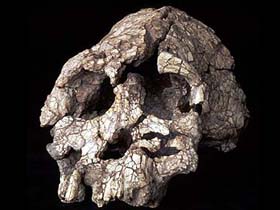In fact, when one looks at all of the fossils discovered to date, it becomes clear that there is no evolutionary progression, beginning from a common ancestor and slowly turning into apes and present day man.
Daniel E. Lieberman of Harvard University's Anthropology Department commented on Kenyanthropus platyops in an article in Nature magazine:
The evolutionary history of humans is complex and unresolved. It now looks set to be thrown into further confusion by the discovery of another species and genus, dated to 3.5 million years ago. . . The nature of Kenyanthropus platyops raises all kinds of questions, about human evolution in general and the behaviour of this species in particular. Why, for example, does it have the unusual combination of small cheek teeth and a big flat face with an anteriorly positioned arch of the cheekbone? All other known hominin species with big faces and similarly positioned cheekbones have big teeth. I suspect the chief role of K. platyops in the next few years will be to act as a sort of party spoiler, highlighting the confusion that confronts research into evolutionary relationships among hominins.5
The BBC reported the story under such headlines as "Flat-Faced Man a Puzzle," "A Confusing Picture" and "A Scientific Contradiction" and went on to say that:
The discovery by Meave Leakey, of the National Museums of Kenya, and colleagues threatens to blur still further the already murky picture of man's evolution.6
Fred Spoor, the famous evolutionist in University College London said that "the fossil raises a lot of questions."7
As can be seen from these statements and admissions, the theory of evolution is facing a major dilemma. In particular, every new discovery in the field of paleontology presents a new contradiction for the theory of evolution to explain. Evolutionists who produce diagrams of the supposed evolution of mankind seek to incorporate new discoveries by setting the fossils out among extinct species of ape and to human races.
4. Bill Sardi, "Is ‘Flat-Faced Man' Your Ancestor?," http://www.lewrockwell.com/orig/sardi3.html
5.Daniel E. Lieberman, "Another face in our family tree," Nature, March 22, 2001, pp. 419-420.
6. http://news.bbc.co.uk/2/hi/science/nature/1234006.stm
7. http://news.bbc.co.uk/2/hi/science/nature/1234006.stm


